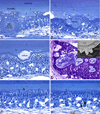Matrix metalloproteinase 20 promotes a smooth enamel surface, a strong dentino-enamel junction, and a decussating enamel rod pattern
- PMID: 22243247
- PMCID: PMC3277084
- DOI: 10.1111/j.1600-0722.2011.00864.x
Matrix metalloproteinase 20 promotes a smooth enamel surface, a strong dentino-enamel junction, and a decussating enamel rod pattern
Abstract
Mutations of the matrix metalloproteinase 20 (MMP20, enamelysin) gene cause autosomal-recessive amelogenesis imperfecta, and Mmp20 ablated mice also have malformed dental enamel. Here we showed that Mmp20 null mouse secretory-stage ameloblasts maintain a columnar shape and are present as a single layer of cells. However, the maturation-stage ameloblasts from null mouse cover extraneous nodules of ectopic calcified material formed at the enamel surface. Remarkably, nodule formation occurs in null mouse enamel when MMP20 is normally no longer expressed. The malformed enamel in Mmp20 null teeth was loosely attached to the dentin and the entire enamel layer tended to separate from the dentin, indicative of a faulty dentino-enamel junction (DEJ). The enamel rod pattern was also altered in Mmp20 null mice. Each enamel rod is formed by a single ameloblast and is a mineralized record of the migration path of the ameloblast that formed it. The enamel rods in Mmp20 null mice were grossly malformed or absent, indicating that the ameloblasts do not migrate properly when backing away from the DEJ. Thus, MMP20 is required for ameloblast cell movement necessary to form the decussating enamel rod patterns, for the prevention of ectopic mineral formation, and to maintain a functional DEJ.
© 2011 Eur J Oral Sci.
Figures




Similar articles
-
Modulation of cell-cell junctional complexes by matrix metalloproteinases.J Dent Res. 2013 Jan;92(1):10-7. doi: 10.1177/0022034512463397. Epub 2012 Oct 9. J Dent Res. 2013. PMID: 23053846 Free PMC article. Review.
-
Kallikrein-related peptidase 4, matrix metalloproteinase 20, and the maturation of murine and porcine enamel.Eur J Oral Sci. 2011 Dec;119 Suppl 1(Suppl 1):217-25. doi: 10.1111/j.1600-0722.2011.00859.x. Eur J Oral Sci. 2011. PMID: 22243249 Free PMC article.
-
MMP20 modulates cadherin expression in ameloblasts as enamel develops.J Dent Res. 2013 Dec;92(12):1123-8. doi: 10.1177/0022034513506581. Epub 2013 Sep 25. J Dent Res. 2013. PMID: 24067343 Free PMC article.
-
Enamel proteins and proteases in Mmp20 and Klk4 null and double-null mice.Eur J Oral Sci. 2011 Dec;119 Suppl 1(Suppl 1):206-16. doi: 10.1111/j.1600-0722.2011.00866.x. Eur J Oral Sci. 2011. PMID: 22243248 Free PMC article.
-
Cellular and chemical events during enamel maturation.Crit Rev Oral Biol Med. 1998;9(2):128-61. doi: 10.1177/10454411980090020101. Crit Rev Oral Biol Med. 1998. PMID: 9603233 Review.
Cited by
-
Proteolysis by MMP20 Prevents Aberrant Mineralization in Secretory Enamel.J Dent Res. 2019 Apr;98(4):468-475. doi: 10.1177/0022034518823537. Epub 2019 Feb 11. J Dent Res. 2019. PMID: 30744480 Free PMC article.
-
Stress response pathways in ameloblasts: implications for amelogenesis and dental fluorosis.Cells. 2012 Sep 1;1(3):631-45. doi: 10.3390/cells1030631. Cells. 2012. PMID: 23745169 Free PMC article.
-
Multi-modal characterization of rodent tooth development.bioRxiv [Preprint]. 2024 Nov 1:2024.11.01.621612. doi: 10.1101/2024.11.01.621612. bioRxiv. 2024. PMID: 39554162 Free PMC article. Preprint.
-
TGF-ß regulates enamel mineralization and maturation through KLK4 expression.PLoS One. 2013 Nov 20;8(11):e82267. doi: 10.1371/journal.pone.0082267. eCollection 2013. PLoS One. 2013. PMID: 24278477 Free PMC article.
-
Modulation of cell-cell junctional complexes by matrix metalloproteinases.J Dent Res. 2013 Jan;92(1):10-7. doi: 10.1177/0022034512463397. Epub 2012 Oct 9. J Dent Res. 2013. PMID: 23053846 Free PMC article. Review.
References
-
- Bartlett JD, Simmer JP. Proteinases in developing dental enamel. Crit RevOral BiolMed. 1999;10:425–441. - PubMed
-
- Smith CE. Cellular and chemical events during enamel maturation. Crit RevOral BiolMed. 1998;9:128–161. - PubMed
-
- Roycik MD, Fang X, Sang QX. A fresh prospect of extracellular matrix hydrolytic enzymes and their substrates. Curr Pharm Des. 2009;15:1295–1308. - PubMed
-
- Bartlett JD, Beniash E, Lee DH, Smith CE. Decreased mineral content in MMP-20 null mouse enamel is prominent during the maturation stage. JDentRes. 2004;83:909–913. - PubMed
Publication types
MeSH terms
Substances
Grants and funding
LinkOut - more resources
Full Text Sources

